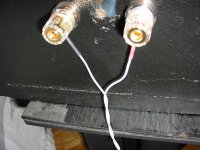Hi all!
Ispired by Junji Kimura's ultra-minimalist approach to audio, I decided to try to make my own diy speakercables. Kind of a clone of the 47 Laboratory STRATOS cable. Well, not exactly a clone, more like doing it minimalist-style. I won't go into any lenghty cable discussion with any religious groups, just give you the recipe I used to give me some sore thumbs and a very good performing cable:
1. 16m 0,5mm^2/22AWG magnet wire (enamelled Cu, 0,7mm outside D)
2. 16m 0,74mm^2/20AWG PTFE tube (teflon 0,86mm inside D)
-Cut into 4 lengths of 4 meters, tread magnet wire into the PFTE sleeving (this is the hard part), make 2 twisted pairs with a hand-drill and voilla -speaker cable finished 😉
Of course you want to let the Cu-wire a little longer than the teflon jacket, and terminate with your favourite termination.
Stripping the magnet wire can be done in various ways (chemical, mechanical, heat) -I simply set my soldering station to 350'C (may vary a lot -experiment with some test pieces first) and "tinn" the ends of the cable. What happens is that the heat/solder tinn/flux melts the isolation/enamel of the cable leaving you with a nice tinned wire end. The secret is correct heat setting and lots of solder combined with some practice in getting the technique down.
BTW -total cost is about $15 for two 4m pairs 😉
Ispired by Junji Kimura's ultra-minimalist approach to audio, I decided to try to make my own diy speakercables. Kind of a clone of the 47 Laboratory STRATOS cable. Well, not exactly a clone, more like doing it minimalist-style. I won't go into any lenghty cable discussion with any religious groups, just give you the recipe I used to give me some sore thumbs and a very good performing cable:
1. 16m 0,5mm^2/22AWG magnet wire (enamelled Cu, 0,7mm outside D)
2. 16m 0,74mm^2/20AWG PTFE tube (teflon 0,86mm inside D)
-Cut into 4 lengths of 4 meters, tread magnet wire into the PFTE sleeving (this is the hard part), make 2 twisted pairs with a hand-drill and voilla -speaker cable finished 😉
Of course you want to let the Cu-wire a little longer than the teflon jacket, and terminate with your favourite termination.
Stripping the magnet wire can be done in various ways (chemical, mechanical, heat) -I simply set my soldering station to 350'C (may vary a lot -experiment with some test pieces first) and "tinn" the ends of the cable. What happens is that the heat/solder tinn/flux melts the isolation/enamel of the cable leaving you with a nice tinned wire end. The secret is correct heat setting and lots of solder combined with some practice in getting the technique down.
BTW -total cost is about $15 for two 4m pairs 😉
tiroth said:Isn't the teflon a bit redundant?
Yes, if you're really hard-core you could do without the teflon.
If you do it that way you get even lower Inductance. (And porportionally higher capacitance, but this is of less importance). The reason I used it (and recommended it) is the risk of shorting the power-amp
 The LCR are reasonably low anyway.
The LCR are reasonably low anyway. My point is that you can make a very good performing cable for almost nothing and ready to go in an evening 😉
Cable/material choice can be anything resembling what I used -use whatever you like/is awailable. As a side note I might add that if I should do it again I think I would choose a PTFE tube with slightly bigger inside dia. because at the end of the treading prosedure the wire was almost stuck in the tube..
Clone this, gain that............?
And how does the MADK-SAN wire perform???
😀 😉 🙂 Details please.........
And how does the MADK-SAN wire perform???
😀 😉 🙂 Details please.........
Re: Clone this, gain that............?
Very well, thank you 😉
It gives a very natural and dynamic presentation. Seems a very good companion to a gainclone. Still burning in though.
Chris said:And how does the MADK-SAN wire perform???
😀 😉 🙂
Very well, thank you 😉
It gives a very natural and dynamic presentation. Seems a very good companion to a gainclone. Still burning in though.
If you truely want to go minimalist style, I would get rid of the binding posts, and simply solder all connections... that would be truely "hard-core" and more minimalist in terms of draining the wallet.
--
Brian
--
Brian
- Status
- Not open for further replies.
- Home
- Amplifiers
- Chip Amps
- GainWire
